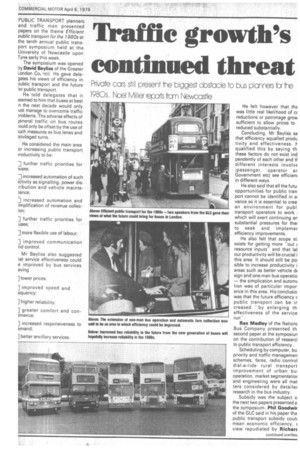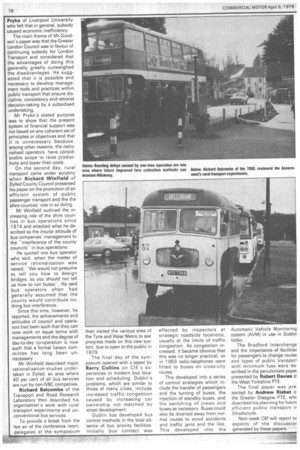Traffic growth's continued threat
Page 79

Page 80

If you've noticed an error in this article please click here to report it so we can fix it.
Private cars still present the biggest obstacle to bus planners for te 1980s. Noel MiIller repots from Newcastle
PUBLIC TRANSPORT planners and traffic men presented papers on the theme Efficient public transport for the 1980s at the tenth annual public transport symposium held at the University of Newcastle upon Tyne early this week.
The symposium was opened by David Bayliss of the Greater London Co, ncil. He gave delegates his views of efficiency in public transport and the future or public transport.
He told delegates that it ;eemed to him that buses at best n the next decade would only ust manage to overcome traffic )roblems. The adverse effects of jeneral traffic on bus routes muld only be offset by the use of puch measures as bus lanes and )rivileged turns. He felt however that thE was little real likelihood of cc reductions or patronage grow sufficient to allow prices to reduced substantially.
Concluding, Mr Bayliss sa that efficiency equalled produ tivity and effectiveness. lqualified this by saying th these factors do not exist ind pendently of each other and ti different interests involvE passenger, operator ar Government etc) see efficien( in different ways.
He also said that all the futu opportunities for public tran port cannot be identified in a, vance so it is essential to crea an environment for publ transport operators to work which will exert continuing ar substantial pressures for thei to seek and implemer efficiency improvements.
He also felt that scope St exists for getting more "out ( resource inputsand that lal our productivity will be crucial i this area. It should still be po: sible to increase productivity i areas such as better vehicle d( sign and one-man bus operatio — the sirnplication and automE tion was of particular impor ance in this area. His conclusio was that the future efficiency c public transport can be ir creased "'by enlarging th effectiveness of the service run".
Rex Medley of the NationE Bus Company presented th second paper at the symposiur on the contribution of researcl to public transport efficiency.
Scheduling by computer, bu priority and traffic managemen schemes, fares, radio control dial-a-ride rural transport improvement of urban bu, operation, market segmentatior and engineering were all mat ters considered by detailec research in the bus industry.
Subsidy was the subject o the next two papers presented a the symposium. Phil Goodwir of the GLC said in his paper tha public transport subsidy coulc mean economic efficiency, view repudiated by Richarc Pryke of Liverpool University who felt that in general, subsidy caused economic inefficiency.
The main theme of Mr Goodwin's paper was that the Greater London Council was in favour of continuing subsidy for London Transport and considered that the advantages of doing this generally greatly outweighed the disadvantages. He suggested that it is possible and necessary to develop management tools and practices within public transport that ensure discipline, consistency and rational decision-taking by a subsidised undertaking.
Mr Pryke's stated purpose was to show that the present system of financial support was not based on any coherent set of principles or objectives and that it is unnecessary because, among other reasons, the nationalised operators have considerable scope to raise productivity and lower their costs.
On the second day, rural transport came under scrutiny when Richard Winfield of Dyfed County Council presented his paper on the promotion of an efficient system of public passenger transport and the the shire counties role in so doing.
Mr Winfield outlined the increasing role of the shire counties in bus operations since 1974 and attacked what he described as the insular attitude of bus companies' management to the "interference of the county councils" in bus operations.
He quoted one bus operator who said, when the matter of service rationalisation was raised, "We would not presume to tell you how to design bridges, so you should not tell us how to run buses". He said bus operators often had generally assumed that the county would contribute nothing but interference.
Since this time, however, he reported, the achievements and attitudes of council and operators had been such that they can now work on equal terms with managements and the degree of day-to-day co-operation is now such that a formal liaison committee has long been unnecessary.
Mr Winfield described major rationalisation studies under taken in Dyfed, an area where 40 per cent of all bus services are run by non-NBC companies.
Richard Balcombe of the Transport and Road Research Laboratory then described his organisation's work with rural transport experiments and unconventional bus services.
To provide a break from the hot air of the conference room, delegates at the symposium then visited the various sites of the Tyne and Wear Metro to see progress made on this new system, due to open to the public in 1979.
The final day of the symposium opened with d paper by Barry Collins on CIE's experiences in modern bus location and scheduling. Dublin's problems, which are similar to those of many cities, include increased traffic congestion caused by increasing car ownership not matched by street development.
Dublin has developed bus control methods in the total absence of bus priority facilities. Initially bus contact was effected by inspectors at strategic roadside locations, usually at the limits of traffic congestion. As congestion increased, it became obvious that this was no longer practical, so in 1969 radio-telephones were fitted to buses on cross-city routes.
This developed into a series of control strategies which include the transfer of passengers and the turning of buses, the injection of standby buses, and the switching of crews and buses as necessary. Buses could also be diverted away from normal routes to avoid accidents and traffic jams and the like. This developed into the Automatic Vehicle Monitoring system AVM) in use in Dublin today.
The Bradford Interchange and the importance of facilities for passengers to change routes and types of public transporl with minimum fuss were de.
scribed in the penultimate papei presented by Robert Davies o. the West Yorkshire PTE.
The final paper was pre sented by Andrew Risbet the Greater Glasgow PTE, whc described his planning for futurr efficient public transport ir Strathclyde.
Next week CM will report or aspects of the discussior generated by these papers.




































































































































































